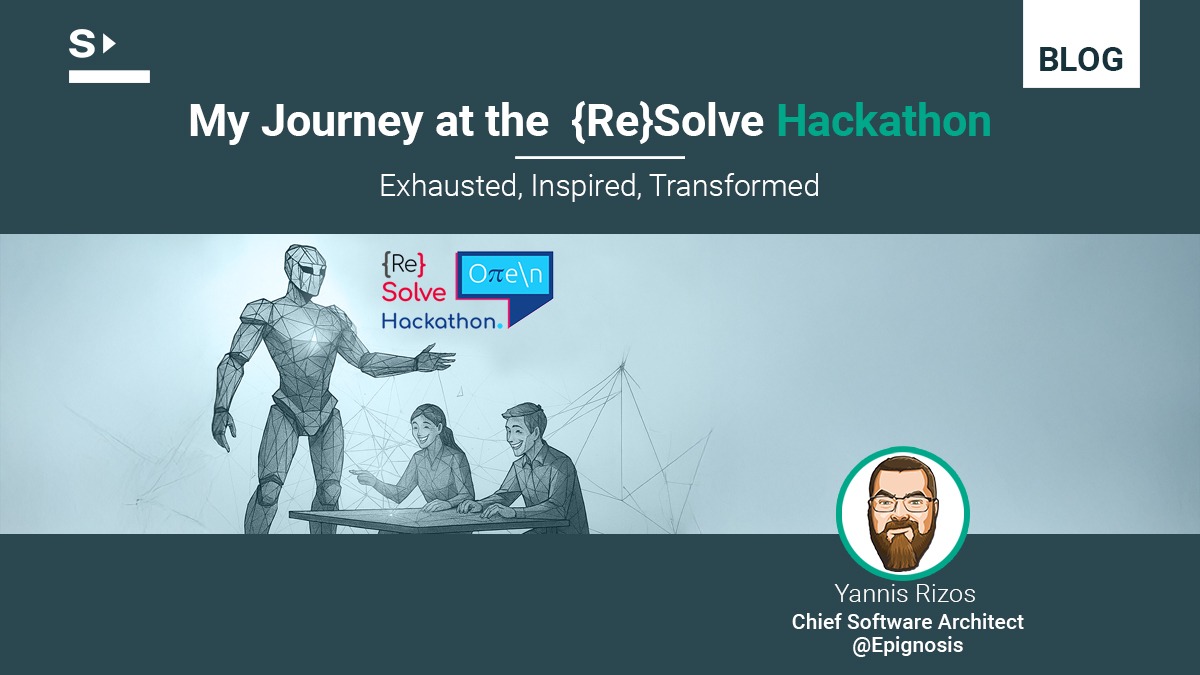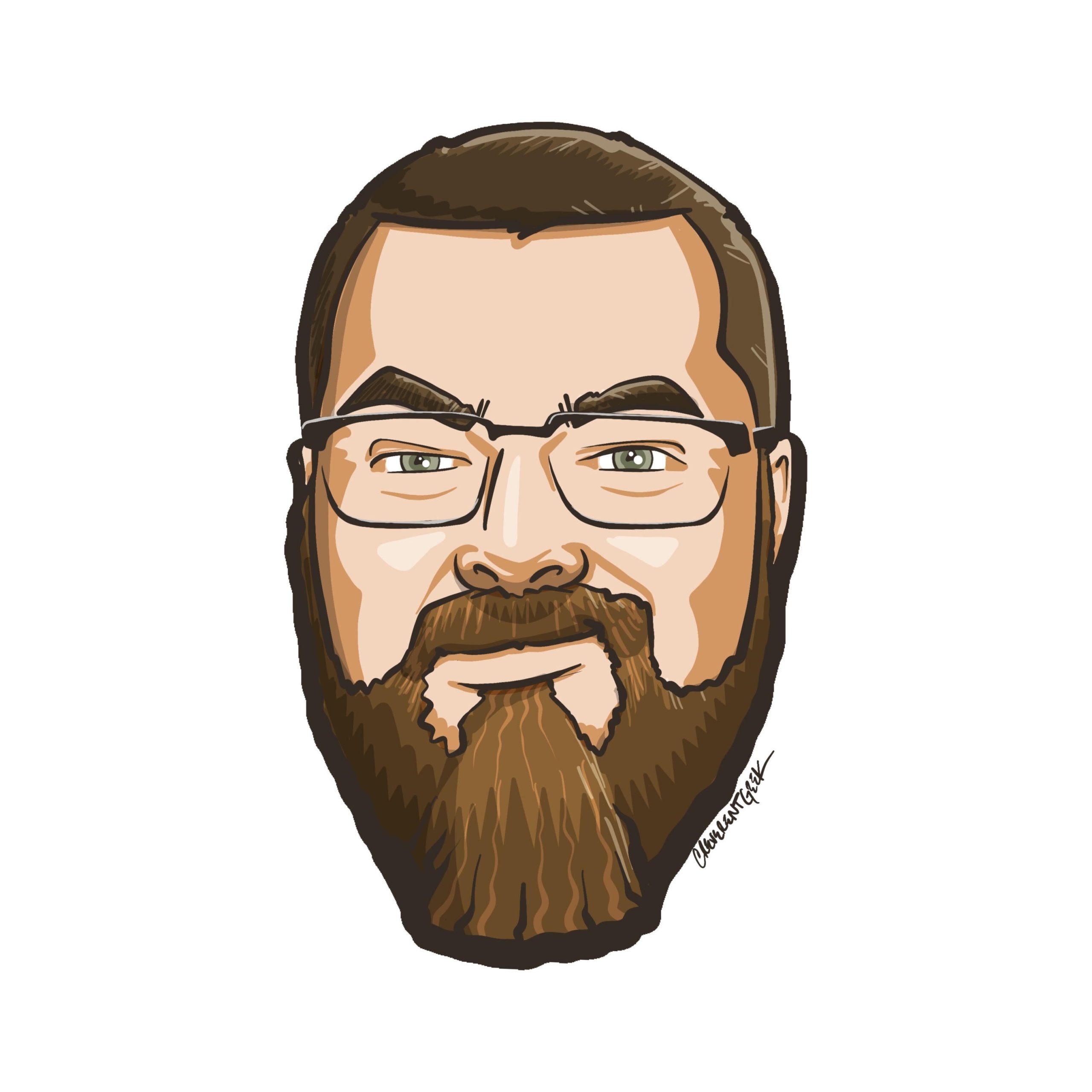From Ancient Theater to Modern Hackathlon

Exhausted.
That single word captures everything after 3 days at the {Re}Solve Hackathon by Open at the Thessaloniki International Fair 2025. The kind that comes from being fully present, from watching builders turn ideas into working prototypes, and from seeing teams create things they had not thought possible. The tiredness felt earned, interesting, fun, and at times humbling.
My alarm went off at 6 am on Friday. I arrived at the airport by 7:30 am, landed in Thessaloniki at 9:30 am, and entered the venue by 10:15 am. By Sunday night, I was back home in Athens. A whirlwind weekend of a thousand freddo espressos. And I was there only to observe and guide. I can’t even begin to imagine how the actual builders felt.
From Ancient Theater to Modern Fair
The path to this exhaustion began in the most unlikely place. August 8th, late evening, walking through the parking lot at Epidaurus after watching Euripides’ Andromache with my wife and daughter. The ancient stones were behind us, the summer air still warm from the performance. That is when Pantelis Stakias appeared out of nowhere.
Pantelis is one of the driving forces behind Open Conf and the Open Hackathon. I had participated in the second Open Hackathon back in June as a primary mentor. When we crossed paths that night, he launched into a rapid-fire explanation. He and Elias Tsaldaris were organizing a hackathon at TIF 2025 in my hometown, Thessaloniki, and they wanted me back. The twist made it serendipitous. Elias had been a participant in the June hackathon, part of a team I had mentored. Now he was helping organize the next one.
I had missed a call from Pantelis earlier that week, so without this chance encounter, the invitation might never have reached me. My wife, standing beside me, could already tell what my answer would be before I even said it.
Perfect and Terrible at Once
Pavilion 17 turned out to be both perfect and terrible for a hackathon. Perfect because we were sharing the space with several universities showcasing their work in engineering and robotics. Students demonstrated robotic arms, racing cars, drones, and AI experiments. The air buzzed with activity.
Terrible because the Fair is massive and packed with people. The noise, the distractions, and the constant flow of visitors discovering what we were doing created relentless interruptions. We were outliers. Most exhibitors were there to showcase products or services. We were there to build.
Visitors would stop, confused about what they were witnessing. “What is this?” they’d ask, watching teams hunched over laptops, deep in conversation about blockchain trust mechanisms and accessibility solutions. “We’re building the future,” someone would answer. Exaggeration? Maybe. Maybe not.
Fortunately, the organizers had managed to find quieter corners where teams could focus when they needed to escape the chaos. Nevertheless, the energy of the larger space was infectious.
Pre-Pitching and Meeting Builders
Friday was pre-pitching day. At the June hackathon, I was still finding where I could help. By September, the questions that mattered had become clearer. Does the team have the right mix of skills? Is the scope realistic for 3 days? Are they solving a real problem or just a technical demonstration? I had begun to trust my instincts about what works.
3 teams were assigned to me as their primary mentor. I worked with them to prepare for presenting their concepts to the larger group, focusing on scope, team skills, originality, feasibility, and communication. I also managed to spend time with other teams. Time was limited, but I valued every chance to connect with builders.
One team stood out early. GenZ, an all-women group with no engineering background. Even for experienced developers, a hackathon takes nerve. They chose to step in with a strong idea: an app to help blind people apply makeup. A practical answer to an everyday challenge faced by millions.
With support from fellow mentor Dimitris Angeloukos, they vibe-coded a working prototype in hours. Watching them move from hesitant first-timers to confident presenters showed how AI-assisted coding closed the gap between idea and implementation and made domain knowledge outweigh coding expertise.
The Accessibility Panel
Saturday was quiet because builders were deep in focus. You could feel the intensity as teams moved from concept to code, from sketches to working demos. The day when ideas either came together or fell apart under pressure.
The highlight was an accessibility panel excellently moderated by Grigoris Lemonis. Participants included myself, Nikos Apostolidis (a seasoned web developer and digital accessibility expert), Theodoros Iliadis from team Vitreous, and George Nasiopoulos from the Interoperability Masters team that had won the June hackathon.
Nikos made a point that tied back to what was happening around us. We need to stop assuming what people who will use our solutions can and cannot do. Instead, we should include them from the early stages and make them part of all core decisions. This is especially true for people with disabilities, who are more often than not excluded from the decisions.
I followed up, saying this was my main takeaway from the Open Hackathon and a key reason I wanted to participate in this one. The organizers had intentionally included people with disabilities as judges, mentors, and subject matter experts. Teams had real opportunities to get feedback from the people who would actually use their solutions.
We discussed approaching accessibility as lived experience rather than just compliance checklist thinking. The difference is profound. Compliance asks whether minimum requirements are met. Lived experience asks whether the solution improves daily life. That same thought echoed what my colleague Thanassis Parathyras had captured in his blog post about the June hackathon:
It’s easy to talk about accessibility in abstract terms. But being in a space where every idea had a human story behind it, that changed something in me.
Final Presentations
Sunday arrived with palpable excitement. The day we’d find out who won, but more importantly, the day teams would present what they’d built. The teams were showing signs of fatigue, but they were discussing their solutions with each other, sharing insights, and offering help.
They were competing for the same prizes, but this didn’t stop them from collaborating. I watched teams troubleshoot each other’s last-minute problems and provide feedback on presentations. Competition hadn’t killed collaboration. In my corporate world, competition often creates silos. Here, scarcity thinking was absent. Teams understood that knowledge sharing strengthened everyone.
While waiting for the presentations to begin, I spoke with a fellow craftsman who had dropped by the Fair. He told me he had to chase down four approvals to get his company’s backing to attend a tech event.
My story was different. All it took was a Slack message: “Hey, this cool thing is happening. I’d like to be part of it. Can we support it?” The answer came back almost instantly: “Of course!” Travel, accommodation, everything sorted without hesitation. For Epignosis and Starttech Ventures, supporting the tech ecosystem is not an afterthought. It is part of who we are.
Soon after, the first team took the stage. What followed was a series of projects that showed both imagination and urgency. Some focused on accessibility, from platforms that performed audits and even fixed accessibility issues in real time to gaze tracking apps designed for people with Rett Syndrome. Others explored blockchain, with proposals aimed at pressing issues. A “wallet of trust” to identify and stop scammers. A service positioned as a “universal trust authority” for ethical funding. A platform for real estate micro-investing.
The judges faced an impossible task choosing the top 3. When the prizes were announced, it was clear there were no real losers. Every team had built something meaningful, gained experience, and formed connections they would not have made otherwise.
Building and Mentoring
Every meaningful decision that teams made was framed as competing forces. Cost, complexity, adaptability, delivery speed, and sustainability weighed against 3-day constraints. Most teams chose pragmatically: get it working first, worry about elegance later. Dan North’s concept of building “The Best Simple System for Now” in practice.
But the more interesting architectural challenge was the hackathon itself as a sociotechnical system. Conway’s Law played out in real time as team communication patterns shaped their final solutions. Teams that spent too much time on infrastructure struggled to deliver working demos. Teams that chose familiar technologies over optimal ones shipped faster. Small decisions about team structure and technology choices cascaded into significant consequences by day 3.
The organizers created boundaries that empowered teams to make local decisions while maintaining overall coherence. Primary mentors provided strategic guidance without micromanaging. Subject matter experts offered specialized knowledge on demand. The structure enabled autonomy while preventing chaos.
The same principles applied: clear interfaces, loose coupling, high cohesion, and emergent behavior from simple rules. This was systems thinking in action, applied to human creativity rather than software architecture.
Coming Home
By the time I returned home on Sunday, a minute shy of midnight, the serendipitous journey from Epidavrus to Pavilion 17 felt symbolic. Ancient theater fading into modern invention, if you allow for a slice of hyperbole.
From June to September, mentoring across two hackathons gave me as much as I gave. The teams taught me as much as I taught them.
If you’re reading this and wondering whether you should volunteer at a hackathon, my answer is straightforward: do it. Not because you’ll feel good about giving back, though you will. Not because it looks good on your LinkedIn, though it might. Do it because you’ll remember why you fell in love with building things in the first place.
The tech community thrives because people choose to contribute. Choose to mentor. Choose to share knowledge. Choose to create space for others to build. That choice is available to anyone reading this. The only question is whether you’ll take it.
The next time opportunity appears in a parking lot, at a conference, or in your inbox, I hope you say yes. The community needs more mentors, more volunteers, and more people willing to support builders. The future is built by people who show up and help others bridge the gap between idea and implementation.
And sometimes, the most meaningful journeys begin with the most unexpected encounters under ancient stars.
